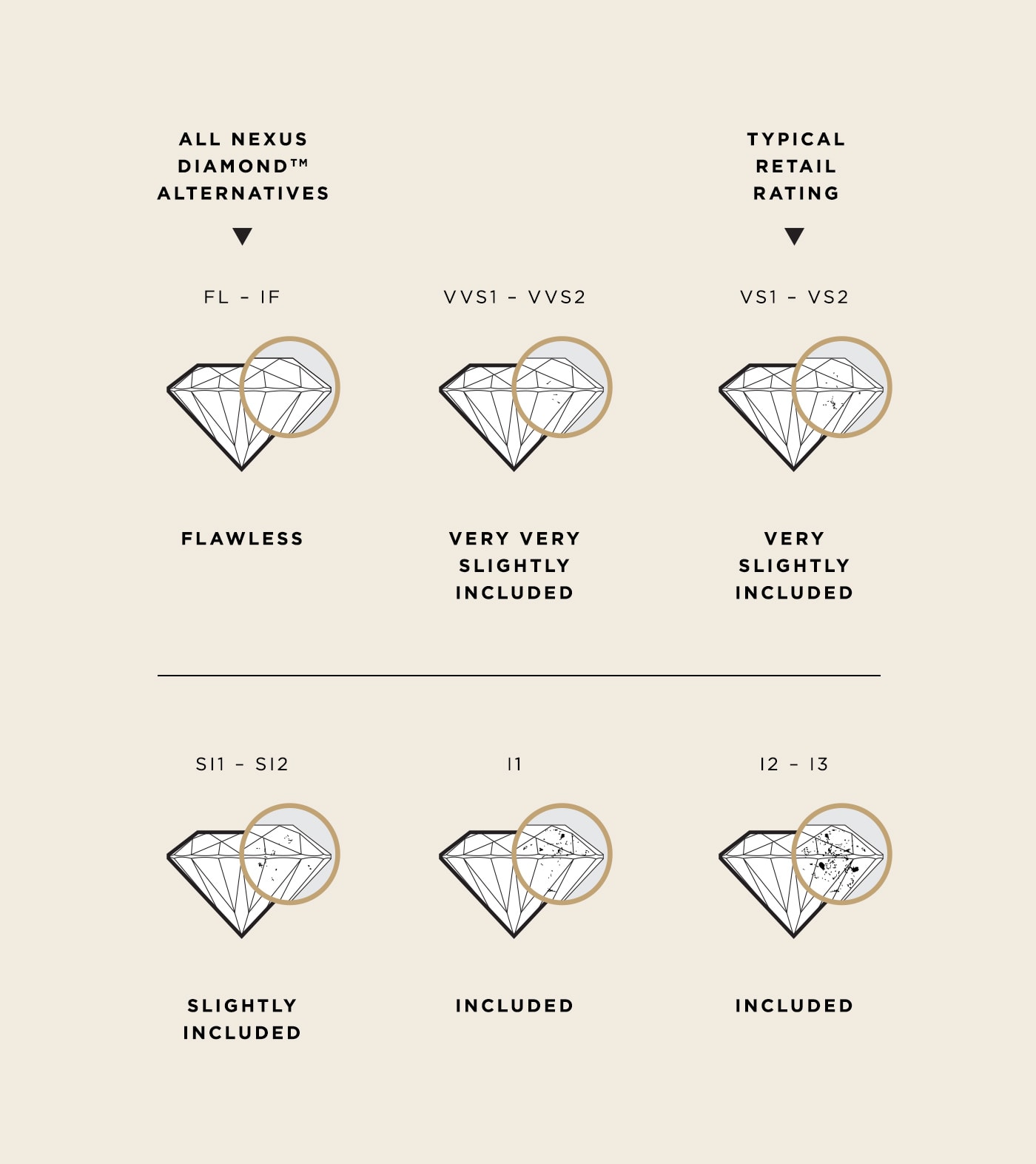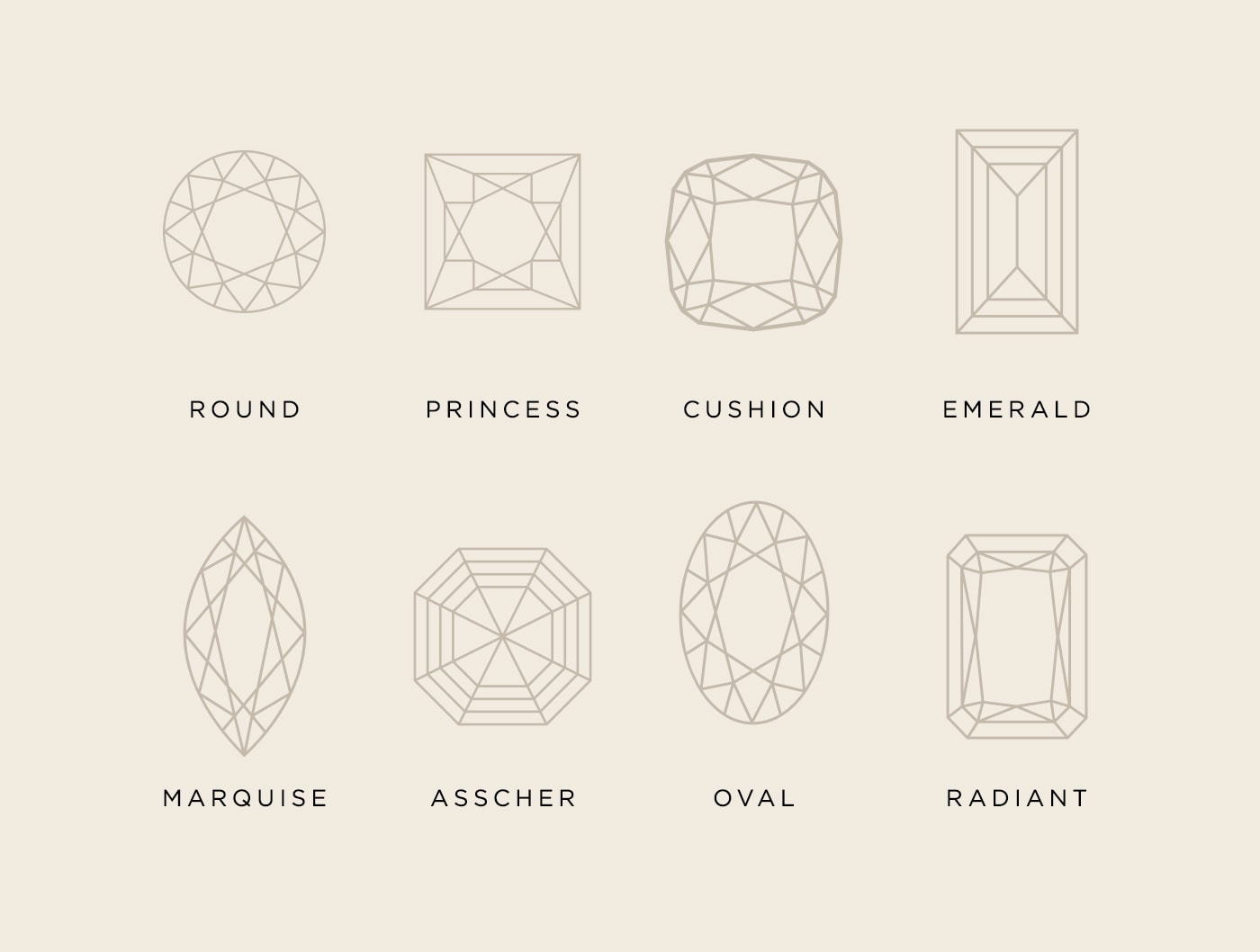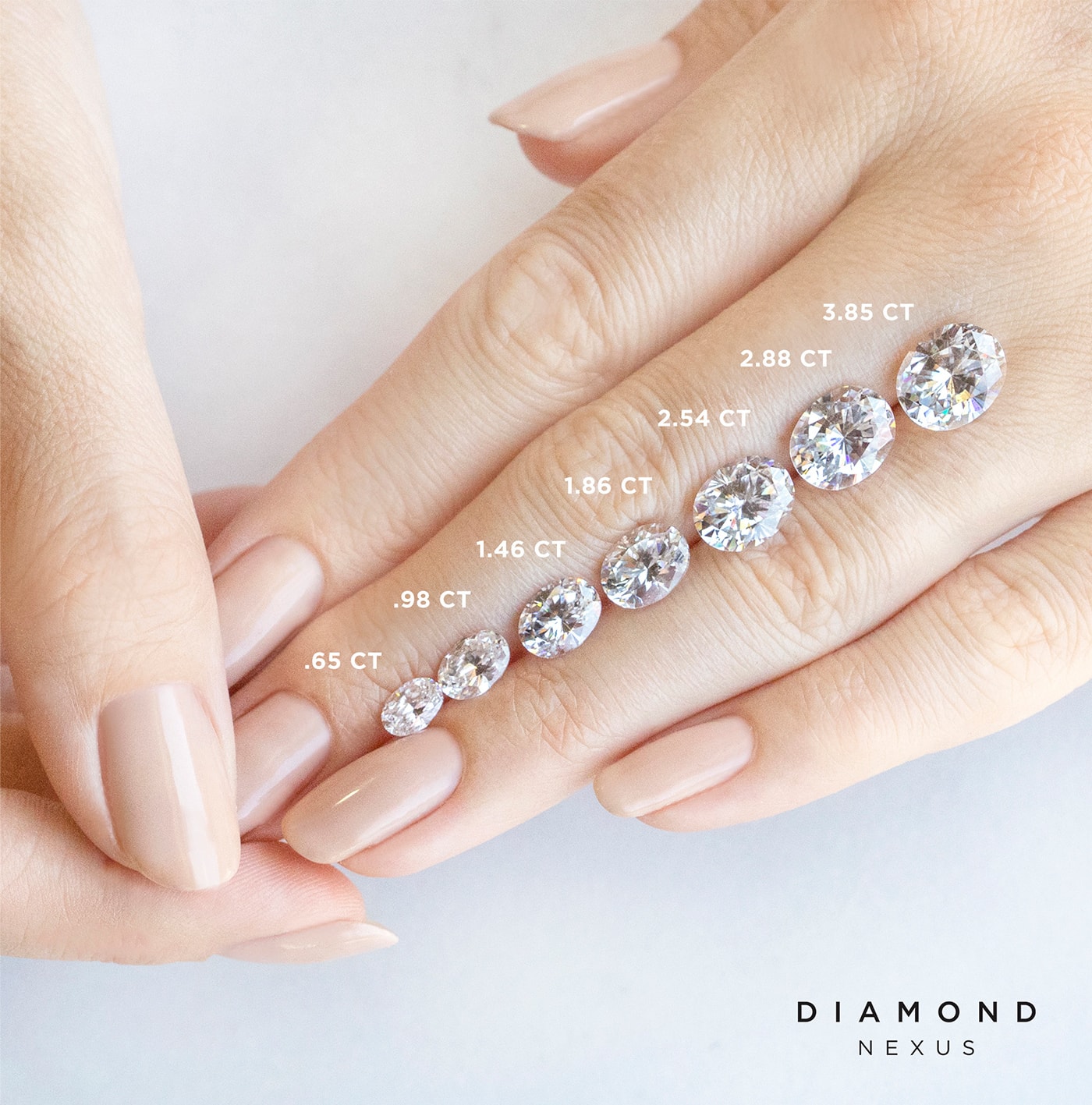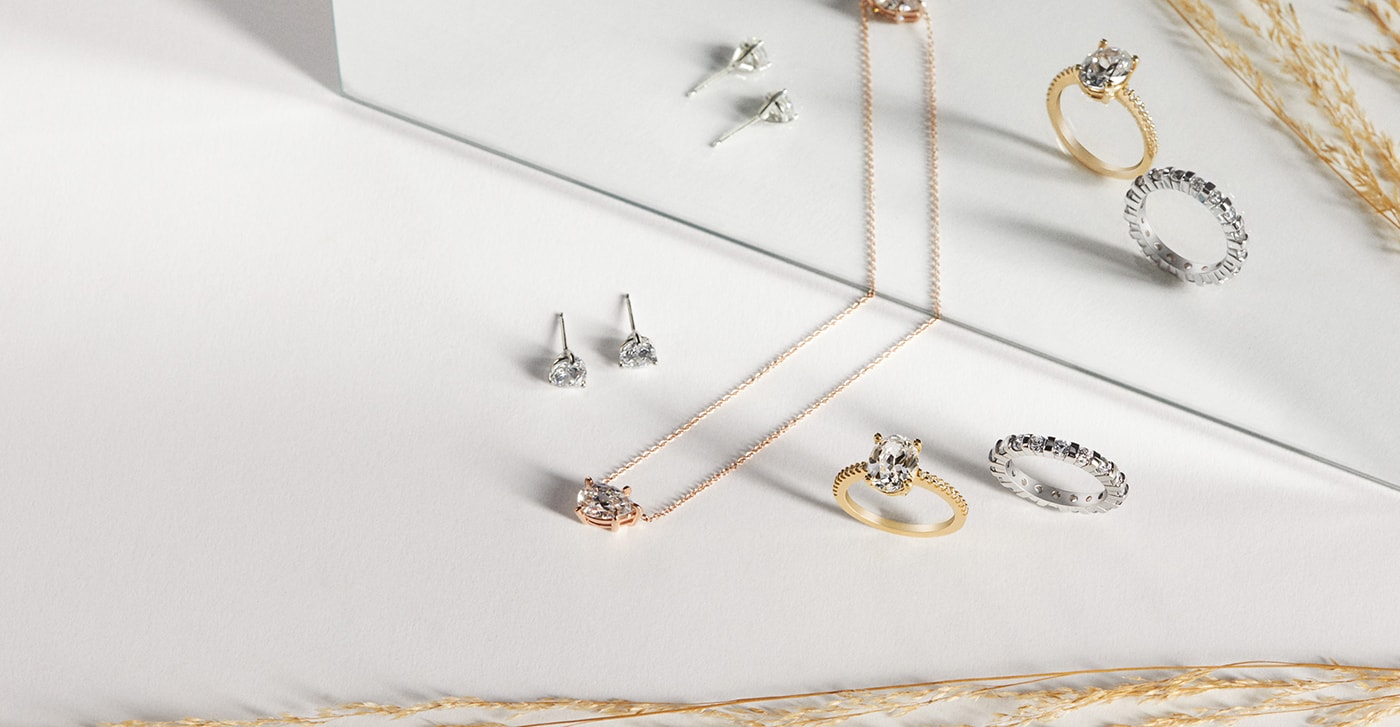Diamond Quality Guide: The 4Cs & More
September 30th, 2019 / Alese Oldenburg
Diamond jewelry is a unique gift that has a special distinction: it’s usually worn very frequently, which means that selecting the right look is essential. Whether it’s a cherished tennis-style diamond bracelet, stunning solitaire stud earrings, or sparkling wedding or affordable engagement rings, it’s fine jewelry that’s meant to be seen.
When a piece of fine jewelry is destined for greatness, it’s important to research attributes like the diamond quality before making a decision. Getting the best quality diamond will ensure your new earrings, bracelet, ring, or necklace remains elegant and on-trend for a lifetime. A diamond quality guide is the best place to start your buying journey, whether you’re looking for natural diamonds or simulated lab grown diamonds. This guide will familiarize you with the famous “4Cs” of diamonds and other considerations to keep in mind when shopping for these eye-catching gems, whether that’s online or with your local jeweler. Read on to learn the basics of determining the difference between a quality diamond and a less-than-optimal one.
The 4Cs of Diamond Quality: Color, Clarity, Cut & Carat

Color
While most people know that a diamond is generally considered white, there are shades of white and decidedly colorful alternative options for diamonds as well. The standard measurement of a diamond’s color is the official color scale established by the Gemological Institute of America (GIA). This scale rates diamonds with a grade from colorless – a perfectly clear, shining stone with no color – to noticeable color – a stone that has a slight yellow tint. Generally, diamonds closer to the colorless end of the spectrum are the rarest and therefore the highest value.

However, diamonds with color can also be an intentional choice to match a style. While white shades are undeniably popular indicators of diamond quality, they shouldn’t be used as a sole deciding factor. A beautiful canary yellow diamond, for example, can be prized as the best quality diamond among its sunny-hued peers, making it an ideal centerpiece for a ring or pendant. Additional minerals or treatment processes can introduce other gorgeous hues into a diamond as well, producing anything from deep emerald green that appears to saturate the stone to a soft rose pink that offers a compelling blush of color.
While some settings, such as the classic solitaire engagement ring, do emphasize a single central stone, design trends have also made a dazzling array of multi-stone settings available. If you’re choosing a colored stone, consider how it will (or can!) interact with the stones around it as you create your ideal jewelry piece. Would you like a clear central stone surrounded by touches of color? A subtle-colored center stone with darker-colored accent stones at its edges? There are many intriguing ways that colored and uncolored stones can interact in diamond and diamond alternative jewelry, so don’t feel as if you have to relegate your diamond shopping to the realm of white stones only.
Clarity
Mined stones are at the mercy of their surrounding bedrock as they geologically form. Variations in everything from soil type to pressure can introduce fractures into the structure, as can certain treatments and cutting procedures performed to create the diamond once it is mined. Some of these fractures and damages are virtually invisible unless the stone is being examined under a microscope or loupe of a trained professional, but others are visible to the naked eye.
The clarity grading scale for diamond quality rates the number of inclusions on an abbreviated scale, marked with letter-number grading scores:
- At one end of the scale, a grade of “FL” translates to “flawless,” which refers to a diamond with no visible flaws inside or out, under 10x magnification. These types of diamonds are very rare and come with price tags to match.
- Moving a little further down, VVS1 and VVS2 represent ascending degrees of “Very Very Slightly Included,” which means the stone does have flaws, but they’re very difficult for a trained diamond grader to spot.
- Under these, you’ll find the VS1 and VS2 grades of diamond clarity, which drop one of the “very” prefixes and stands for “Very Slightly Included” – it’s reasonably easy for a trained grader to notice these under magnification. At this range of the scale, an untrained grader may notice one or more inclusions without magnification, depending on the shape of the stone and where the flaw is situated.
- A little lower, SI1, SI2, and SI3 are applied to stones that are “Slightly Included,” and have some of the easiest flaws to locate under magnification. This area of the scale represents the point where flaws are starting to become visible without magnification.
- Finally, at the other end of the scale, I1, I2, and I3 are simply “Included,” with flaws that are likely not only visible without magnification, but may also affect the structural durability of the stone itself. (It’s important to note that these aren’t necessarily “bad” diamonds, merely speckled or flawed in a way that can be spotted by the casual observer. Depending on their intended setting, even I3 diamonds can support a beautiful overall design.)

Cutting mined stones involves “working around” graded flaws and inclusions, with the diamond cutter adding extra facets or cutting the stone a certain shape or size to minimize visible flaws. Finding a mined diamond with a minimal amount of these issues and finding a skilled gem cutter to finish the stone is extremely difficult, which is why Nexus Diamond™alternatives are incredibly popular. With diamond simulants, the variables and inclusions that create flaws in mined stones are essentially removed from the sourcing process. This makes it so that every diamond alternative stone can be created with a rating of Internally Flawless.
Cut
A diamond’s cut is one of the most important factors in determining a quality diamond. The cut is officially measured on the GIA’s diamond cut scale, which uses six distinct grades. Depending on how the diamond is physically cut from the stone, it can range in quality from Ideal to Poor cut. The cut of a stone will affect how “sparkly” the finished stone is, how high or low it sits within a setting, and will set the tone for aesthetic attributes.
Another important component of a diamond’s appearance and brilliance that many people actually get confused with the official cut scale is a stone’s shape. There are a number of classic diamond ring shapes that remain timeless and popular, but an exciting crop of new, trendy shapes are slowly filling out the ranks as well. With Round Diamonds holding court as the traditional stone shape, the category of “fancy shape” diamonds encapsulates all other shapes.

- Round Diamonds: The classic, brilliant-cut most well-known for its place in engagement rings and solitaire earring studs, this sparkling shape reflects light beautifully, giving an overall dazzling appearance. It’s typically used for “centerpiece” stones, in settings that will emphasize the round silhouette.
- Princess Diamonds: Square in shape, these elegant stones take their name from frequent appearances in royal, ceremonial jewelry. Cut to emphasize a stone’s size, this shape is tasteful and rich, with clean, straight lines that make it an excellent addition to modern settings.
- Cushion Diamonds: Similar to a princess shape, a cushion-cut diamond is still generally square in shape, but features rounded edges and corners. This gives it a romantic or vintage feel as opposed to the crisp, tidy silhouette of the princess.
- Emerald Diamonds: A rectangular shape derived from the precious gem of the same name, an emerald diamond shape features long internal lines that are stepped or tiered downwards. If round and princess-cut stones are like the light glittering on ocean waves, think of emerald cuts like a clean, clear pool surrounded by elegant submerged stairs.
- Marquise Diamonds: The marquise shape has several alternative names, such as navette, but it is effectively the “diamond-shaped diamond.” Like a boat or a vertical eye, the stone comes to a top and bottom point with rounded edges bowed out at the sides.
- Asscher Diamonds: Popular in both antique and modern jewelry, the Asscher cut is named for Joseph Isaac Asscher, a Holland-based diamond company that created and used the cut in the mid-1700s. A blend of the square and emerald cut, it uses multiple stepped facets within for the brilliance of a square shape with the unique eye-catching center of an emerald.
- Oval Diamonds: Oval cuts mimic the brilliant faceting of round shapes with elegant elongation added to the mix: they offer more “square footage” for light reflection within the cut, though larger facets may be more visible to the eye as a result.
- Radiant Diamonds: The radiant shape is a blend of square-cut and Asscher cut techniques, offering appealing clean lines with (unsurprisingly) radiant light-reflecting facets.
Carat Weight
Contrary to popular belief, carats do not necessarily refer to the overall physical size of a stone (e.g., its length, width, and height). Instead, they refer to the physical weight of a stone, with one carat weighing approximately the same as a standard metal paperclip. As the carats of a stone creep up, referring to it as the colloquial “rock” might be more accurate than most realize. That said, much like the other three “Cs” of diamond quality, it can’t be considered in silo.
A high-carat diamond ring may be large or heavy, but a less-than-optimal color or a poor cut can make it look less than stellar. Likewise, even the most flawless stone and perfect cut can be a bit unimpressive if they’re used on a stone too small to show off these features. Carat weight isn’t a bad place to begin your diamond buying journey, but you should also take factors like budget and overall appearance into consideration in order to find the best piece of diamond jewelry for the best price.
If big carats are a must, temper the cost with a sparkling diamond alternative for the best of both worlds. Not only are they exponentially easier to source than mined diamonds, but each one is created to be Ideal cut and internally flawless. It’s also easier to find large, impressive stones that fit as snugly into your budget as they do complementing settings, since Nexus Diamond™alternatives cost up to 80% less than their mined counterparts.

What To Know Before You Go Diamond Shopping
Have an idea in mind before you begin looking at diamond jewelry, and think of an aesthetic that matches your ideal diamond jewelry. When you envision yourself or your loved one wearing the piece, what type of clothes do you see? Is the surrounding outfit being worn flashy and modern, or more subdued and romantic? Knowing how your new diamond completes a look is an important part of the process because this general idea can help you easily hone in on the 4C qualities you’re looking for, as well as four other considerations:
- Consider how it will wear: Is the piece suitable for everyday style, or would it clash with existing outfits and accessories? Can it be safely and easily worn during a day at work, or is injury/damage to the piece a threat?
- Consider how it will age: While styles like the Asscher cut prove that elegance is always trendy, make sure that the 4C qualities of the diamond or diamond alternative you’ve got your eye on will be as personally cherished years from now as they are today.
- Consider how it will feel: Even if a diamond ring fits well in terms of band size, it doesn’t necessarily mean it will be a good fit overall. The height of the stone, the width of the design, and other fit factors should be weighed as heavily as the band size. A beautiful diamond loses some of its metaphorical shine if the wearer has to constantly fiddle with it and adjust it to sit correctly.
- Consider how it will match: For sentimental jewelry such as engagement rings, wedding rings, and anniversary gifts, design themes and matching are important. An engagement ring might be selected, for example, with an eye towards the matching bridal set, or an anniversary selected for its stacking design to build as the years go by.

Summary: How To Recognize A Good Diamond
Your diamond jewelry should not only look beautiful, but it should also be carefully selected for meaning, design, and expression. Whether you choose a mined stone or a Nexus Diamond alternative to sparkle at the hand, wrist, throat, or earlobes, your best advice is a little research beforehand. Remember to follow the 4Cs and the four considerations when you are choosing a diamond and you’re sure to find the perfect personalized treasure among a glittering trove of beautiful stones.
1 “4Cs Of Diamond Quality.” GIA 4cs.gia.edu, (no publish date), https://4cs.gia.edu/en-us/4cs-diamond-quality/. Accessed August 18, 2019.
2 Fried, Michael. “Marquise Diamond Buying Guide.” The Diamond Pro, August 14, 2019, https://www.diamonds.pro/education/marquise-cut. Accessed August 18, 2019.
3 Fried, Michael. “Diamond Carat Weight Guide With Diameter Size Chart.” The Diamond Pro, March 26, 2019, https://www.diamonds.pro/education/carat-weight/. Accessed August 18, 2019.
*Diamond Nexus strives to provide valuable information, while being clear and honest about our products. The Nexus Diamond™ alternative is a patented lab grown stone that, among all simulants, most closely imitates the look, weight and wear of a mined diamond, with two exceptions – it is absolutely perfect in every way, and it costs significantly less. Price points and environmental facts expressed in this blog were taken from popular online retailers and may vary. Learn more about the environmental impact of mining by visiting our blog

